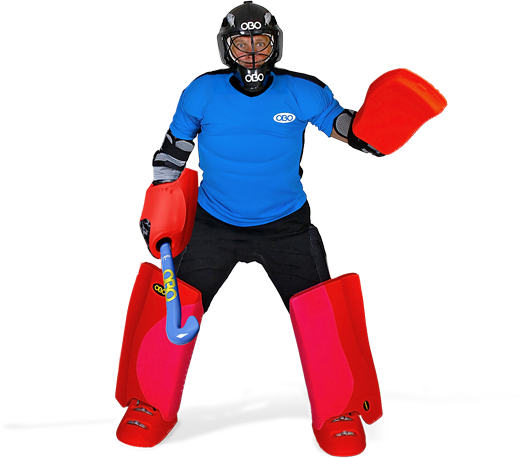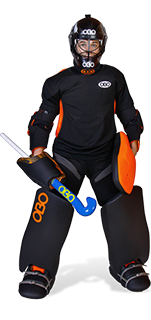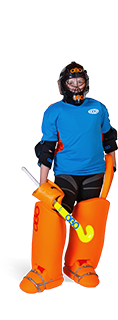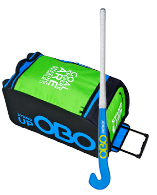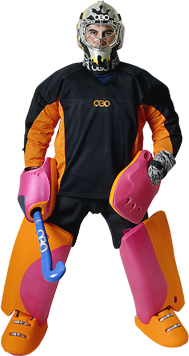KEEPERS RESOURCES

Off Season Training
To borrow a line from Shakespeare, “Now is the Winter of our discontent.” For keepers in the Northern Hemisphere, Winter means snow, sleet and a break from outdoor hockey. For those in Southern Hemisphere, Summer and the heat provide the break. Wherever you are and whatever the time of year, at some point you’re going to have a break in your hockey season (my source of discontent). As the holidays approach, I’ve received a lot of questions about off-season training programs and activities.
The longer you play and the higher the level, the more you’ll find that what you do during that time will impact what your next playing experience is going to be like. Hockey has become a year-round sport and not all of that preparation comes in your playing season. At the international level, months and sometimes years are spent as a build-up to peaking for a two-week period. While your off-season preparation may not make the difference between Olympic Gold or also-ran, it can be the difference to in-season success.
What’s appropriate as your off-season training program depends on a number of things; age, playing experience, fitness, athleticism, skill-level, weather, facilities, dreams and goals are all factors in determining what’s the best off-season program for you. First off, please check Rachel’s Tip on Off-Season Training. There’s a lot of good information there. Second, there is no one right off-season training program for everyone. The best program for you, depends on you.
I want to reinforce a couple of things Rachel mentions. A training diary is critical if you’re serious about improving your game. I’ve heard it said many times, if it’s worth doing, it’s worth writing about. Putting things down on paper reinforces accountability. It can make dreams real. I don’t keep a diary, as much as I keep a journal. During the season I’ll write down what we’re working on in training, practice and games. I’ll track my strengths and weaknesses, things like how I feel and what I’m doing. At the end of the season, I’ll look back at the journal and use it to plan my off-season program.
It’s a good idea to work with your coach when you plan your off-season program. By working with your coach, you gain a couple of things. You find out what your coach thinks of your game, you get feedback on what to work on and you get a better picture of what your coach wants from the position. In developing your program, use all the available resources to you, especially when it comes to experts outside the sport.
As a coach, I won’t pretend to be an expert on a lot of things that contribute to success on the field (i.e. building strength and speed, increasing aerobic capacity, etc.), but as a player, I was good at finding people who were and using their insights. If you want to get faster, find a track coach; stronger, find a strength coach; and so on and so on. If you can’t find a person, find a book. The more information I had, the better. After all that, go back to your coach. It’s important to prioritize what you want to accomplish in the off-season. Some goals can not be met in eight weeks.
Now (finally), about training programs.
I’m a big fan of aerobic activities in the off-season and as much as most keepers play goals because they hate running, I think running is important. As a player, we always had to do the same fitness tests the field players did in selections. At least one of those tests was an aerobic test, whether it was a five-minute run, a twelve-minute run, a timed five-mile or 5km run. Nothing did more to hurt my confidence, or perception on the team, than to finish last in those runs. I don’t know that the ability to run 1500 meters in five minutes made me a better keeper, but it made me a better athlete.
There are a wide variety of aerobic activities that are excellent for building endurance. Swimming, roller-blading, cycling and jumping rope are all good activities. How long and how hard you do these activities will obviously depend on things like age and your starting fitness. As a general guideline, aerobic means more than fifteen minutes of continuous activity. If you bike or blade and are stopping every other block, it no longer constitutes an aerobic event. In the off-season, I like to fit in two or three aerobic workouts a week.
Speed work is important. The further away from the start of the season I am, the more I try to focus on sprint work at longer distances. Sprint work is any distance shorter than 400 meters. As I get closer to the start of my season, I’ll move to shorter distances. Once again, things like distances, repetitions and recovery time between sprints will vary from keeper to keeper.
Agility is important. I can’t just be straight line quick, I need to be able to change direction. Basketball and soccer are good sources for agility drills. I make up a lot of patterns built around movements inside the circle. I’ll place anywhere from ten to twelve cones around the circle in different positions and incorporate the movements I’ll use in the circle: forward, backward, side shuffle right, left, etc. I’ll place them anywhere between three to ten meters apart and make keepers touch the cones to make things more dynamic. I won’t do these things in pads, and I like to keep the drill so the total distance they’ll do in a drill isn’t more than 75 meters. Once again, distance, repetitions and recovery will depend on the keeper. I try to fit in two or three speed/agility workouts a week in during the off-season
Rachel makes a really good point about working out of pads in the off-season. I want to be excited when I get in to pads during the season. Having said that, depending where you are, indoor hockey might be an option. I highly recommend it for keepers. The number of touches, types of situations you face and decisions you have to make happen more frequently in the indoor game. A keeper can see more shots in three indoor games than he does in an entire outdoor season.
I think soccer is a great off-season activity, not as a keeper though. In earlier tips, I’ve mentioned the importance of kicking. Playing soccer in the field allows you to work on aerobic fitness as well as kicking.
I like to throw in reflex workouts/activities into my off-season also. Tennis or racquetball are good for working on eye-hand coordination. I mentioned that you make best use of the facilities you have available to you at the time of year. I’ve used racquetball courts to do soccer ball work. In the Summer months, I’ll move my workouts to the beach. Be creative, make up games or drills.
Strength training has become a major part of all sport. Explosive leg strength is critical to goalkeeping. Hamstrings, quadriceps and calves are important muscles. Upper body strength is required for quick recovery. While a keeper doesn’t need to be the Incredible Hulk, he does need to be able to lift his body weight. If you don’t have access to weights, things like push-ups, pull-ups, squat thrusts and knee bends are good alternate exercises.
Anytime you workout, it’s important that you warm up. Warming up means, a short jog, followed by a complete stretch. By the same token, following your workout, it’s important to warm down and stretch.
Finally, one important thing about an off-season training program, take some time to do nothing. Rest is important. Burnout is a real problem in sport. Too many times I see keepers go straight from their outdoor season, right in to an indoor season and all the rigors of training full time for both. Your body and mind need a break.
Some things need to be done just to have fun. Recognize that. When you’re doing a fun workout, keep it fun, but know that it’s different than a hard workout. Hard workouts aren’t always fun. There’s the need for both the hard and the fun and good off-season training programs capitalize on them.
Good luck,
Jon
e-mail Jon
Please note that OBO together with Jon O’Haire hold copyright over any material appearing on tips pages. We welcome the printing and distribution of these tips, provided that they are not sold, or used for financial gain. This paragraph must appear on all printed or distributed copies. The photographs above must not be used in any form without express permission from Jon O’Haire.
Comments
Leave Your Comments Below















